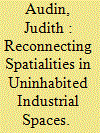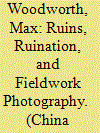|
|
|
Sort Order |
|
|
|
Items / Page
|
|
|
|
|
|
|
| Srl | Item |
| 1 |
ID:
182942


|
|
|
|
|
| Summary/Abstract |
Far from dense Chinese cities that experience fast demolition, ruination in Kouquan, a coal town in Datong, is a slower process that generates new practices and meanings. Uninhabited industrial spaces continue to produce a sense of place where large industrial corporations no longer operate and where most residents have moved away. This article brings out new perspectives on the effects of ruination in an industrial area by moving away from the lenses of the work unit, demolition, heritagisation, or decline. Based on direct observation, informal discussions with local residents from 2016 to 2019, and an online review, this article shows that ruination produces spatialised narratives and practices closely entwined with the local population’s experiences, as well as with other actors’ direct and indirect interactions with places: these actors reconnect to the uninhabited town through dwellings, artistic production, religious practices, or simply through their visits to Kouquan, becoming urban explorers themselves. Ruination leads remaining residents, former locals, visitors, government actors, journalists, and artists to the production of new representations of the uninhabited town.
|
|
|
|
|
|
|
|
|
|
|
|
|
|
|
|
| 2 |
ID:
182939


|
|
|
|
|
| Summary/Abstract |
This article offers a self-reflexive critique of ruins as method by examining side-by-side the production, circulation, and meaning-making processes around the ruin photography of ghost cities in China and the author’s own production of a fieldwork archive of the same photographed spaces. The ruin is commonly understood in recent scholarship to be a deeply ideological artefact with meanings contingent on class-inflected practices of ruin appreciation. In a similar vein, photography of urban ruins has been heavily criticised for allegedly aestheticising social ruin and economic decline. The critique of ruin photography as a practice of ideological claim-making or as a form of critical engagement merits scrutiny in light of this issue’s field research practices looking at ruins in China. More specifically, photography is a standard part of fieldwork, including the author’s. The aim of this article, then, is to ask how and why photographs of urban ruins in China differ across image-making practices? How are fieldwork photos of ruins, the kinds of photos that generate a data archive and are used in scholarly publications, resonant with other ideological claim-making purposes of ruin photography? How might we account for the political valences of image aesthetics when photographs are a vital part of scholarly efforts?
|
|
|
|
|
|
|
|
|
|
|
|
|
|
|
|
|
|
|
|
|